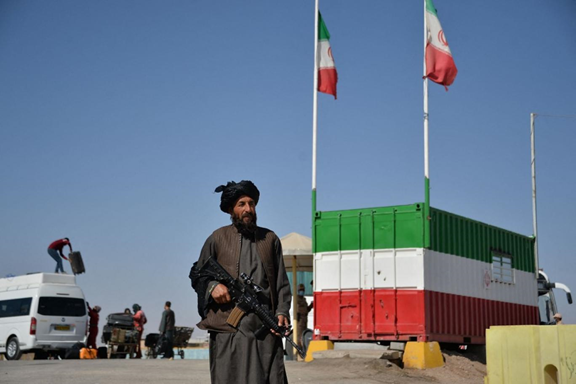Who benefits from the escalation of tension between Iran and Afghanistan?

Mehr News, International Group: With the arrival of August, the third anniversary of the Taliban taking power in Afghanistan arrived The Doha agreement in 2020 and the withdrawal of international coalition forces from Afghanistan indicate the beginning of a new chapter in the political sphere of Iran’s eastern neighbor centered on the Taliban group. Since that time, the Islamic Republic of Iran has started informal relations with the Taliban group based on “common interests” and “political pragmatism”, considering the interests of the Afghan nation.
Files such as “Haqaba Hirmand”, “Growing power of the Khorasan branch of ISIS”, “Border tensions”, “The issue of immigrants”, “The threat of drugs and the phenomenon of smuggling” , “Afghanistan’s Shiites and Farsi-speakers” and “formation of an inclusive national government” are among the issues discussed between the authorities of the two countries, but the enemy intends to increase the level of tensions between Tehran and Kabul by blackmailing each of the mentioned cases. Based on this, in the continuation of this note, we will try to answer the question of who really benefits from the escalation of tension and enmity between the nation state of Iran and Afghanistan?
Although there are no exact statistics on the number of Afghan immigrants inside Iran, some sources put the number of Afghan immigrants active inside the country at 5-7 million people. estimated The existence of such an immigrant community inside the country has made the Islamic Republic of Turkey the largest immigrant-receiving country in the world. In recent years, with the strategy Supreme Leader, the system has decided to provide the necessary platform for a peaceful and dignified life of Afghan immigrants, so that they can use the government’s indirect subsidy on basic goods every day and even their children without any hindrance. study in Iranian schools.
This link was so deep that during the republic, many of the country officials in Afghanistan were graduates of Iran’s top universities. The presence of immigrants in the eastern and central cities of Iran is so high that some local reports report the stunning presence of the immigrant community in elementary school. However, the nation-state of Iran has never disrespected its guests and based on the principle of “Islamic brotherhood” and “Persian civilization” they made them the partners of Iranians. In such a situation, the United States, the Zionist regime and some governments in the region are trying to provide the basis for the escalation of tension between the two brotherly nations based on their geostrategic and short-term interests.
Given the presence of millions of legal and illegal Afghan immigrants in Iran, one of the enemy’s tactics to make the interior of the country insecure is to create artificial differences between Iranians-immigrants and reflect Its direction is in social networks. For example, in the case of Haqaba Hirmand, “Iran International”, a media affiliated with the Mossad service, in two sections, “Persian” and “Dari”, is trying to bring the Iranian and Afghan audience to the conclusion that the other side has value for national interests and security considerations. Tehran or Kabul does not agree. In this line of psychological operations, the Afghan audience is indoctrinated with the view that Tehran has received Hirmand’s rights in full for decades without paying a small fee and has oppressed the Afghan farmers! On the other hand, the “Persian” section of this Zionist media is trying to make the public opinion of the people of Sistan and Baluchistan pessimistic about the performance of the eastern neighbor of our country by publishing pictures of Hamon’s critical situation.
In another case, on Saturday, June 6, 1402, Iranian border guards did not allow a convoy carrying smuggled goods to cross into our country, and this issue caused a conflict between the parties. After this incident, the Taliban forces, who were apparently unaware of the issue; They started shooting at the Iranian side, which led to a conflict between the border guards of the two countries. Unfortunately, during this conflict, two of our country’s border guards were martyred, and many others were killed and wounded. In both cases, the opposing media tried to direct the armed forces to a retaliatory response by republishing images and videos related to the border guards of the two countries and spreading false information to the public opinion of Iran. If these news agencies succeed in influencing the public opinion of Iran and Afghanistan, then the security apparatuses of the parties must prepare themselves for difficult and complex challenges.
Bahre Sakhan
The increase in tension between the two nations of Iran and Afghanistan is a “zero sum game” and has no winners except the Western colonialists and their allies in the region. While the people of Afghanistan are tired of war and insecurity more than ever, the Westerners, with the cooperation of some countries in the region, are planning to once again light the fire of war in this region and by making Afghanistan insecure, the necessary ground for the regrowth of terrorism and extremism from a To harm and insecure the geography of Iran, Russia and China. The war-torn and insecure Afghanistan will provide the Americans with the opportunity to disrupt China and Russia’s access to the southern part of the world and after some time put them in a geopolitical suffocation situation. Understanding this threat will help the Iranian audience to control the tension with the ruling power in Kabul and to pursue national interests by considering the long-term strategy of the West.





